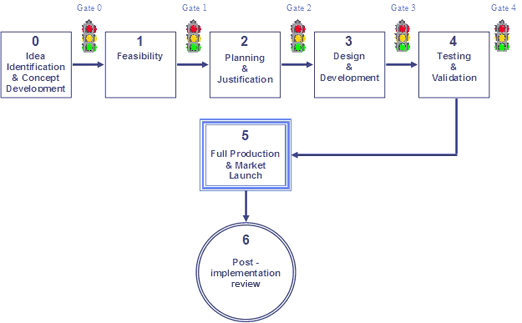|
|

article
page | 1 | 2 | 3 | 4 | 5 | 6 | 7 | 8 | 9 |
So neither “technology first” nor “customer first” is the correct, long term approach. It’s all about balance…
Gates
During the “customer first” process revolution, the NPI process became a widely recognized structure. In this structure, a sequential series of product/customer explorations were set forth to answer specific questions and establish key product enablers and features. Milestones were established that allowed a company to judge progress and predict product “fitness” and to decide whether to continue toward launch or not. Because a product must pass through this review in order to continue, these milestones were called Gates. Some time ago, in the article Speed Kills, LTC advocated the following NPI phases, as providing a metrics-driven and complete approach that would enhance the probability of what we now call “Time to Money”:
|
|
So, how can an MSD be done well, owned by one person, with contributions from all in a timely and thorough manner? |
|

|
At the end of each phase is a Gate: a specific review using performance tests that objectively determine whether or not a product should progress to the next phase. Associated with each Gate is a governance team and an outcome owner – who must certify the benchmark for passage was met for the product to progress. If the performance metrics are not met, the project is terminated – immediately. It is really important to note that this termination is considered a success: it has successfully saved the company from squandering resources on a product that upon further analysis was not shaping up to yield the profits expected. This is the whole point of a good NPI process: get the best possible products to market as quickly as possible. Don’t let a mediocre, or failing idea tie up people, money, and time. If the “go” and “no go” criteria are set at the |
|
|
 Figure 1: LTC International's classic process for NPI
Figure 1: LTC International's classic process for NPI
|
|

- Phase 0 —The Product Identification & Concept Development Phase
- Phase 1 — Feasibility: What is this product – and could it fly?
- Phase 2— Planning & Justification: The Devil Is in The Details
- Phase 3 — Design and Development: New Products Begin to Take on Life
- Phase 4 — Testing and Validation: Becoming Comfortable with the New Product
- Phase 5 — Full Production and Market Launch: Going Forward with Full Confidence
|
|

outset, then no ego need be damaged in initiating the termination action if the Gate Score is in the “no go” zone.
Today, this notion of Gates is under siege. In a desire to become “nimble” and “agile,” to speed products to market as fast as possible, many companies are wondering if the NPI process is just too burdensome. Have NPI gates become too high a hurdle for companies under competitive pressure? (Never mind that Gates were rarely used correctly…more on this point follows).
article
page | 1 | 2 | 3 | 4 | 5 | 6 | 7 | 8 | 9 |
|
|
|




